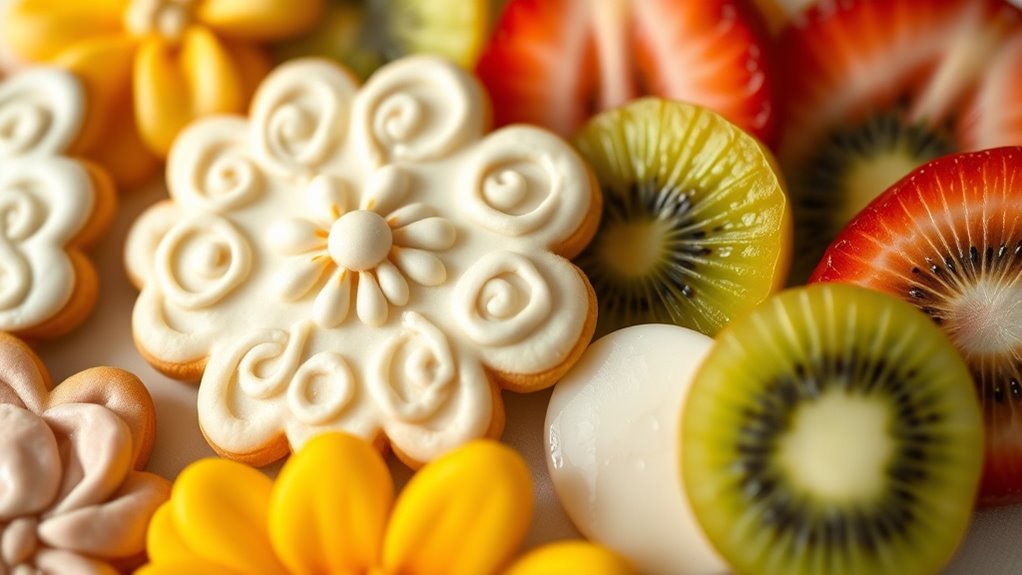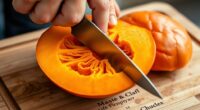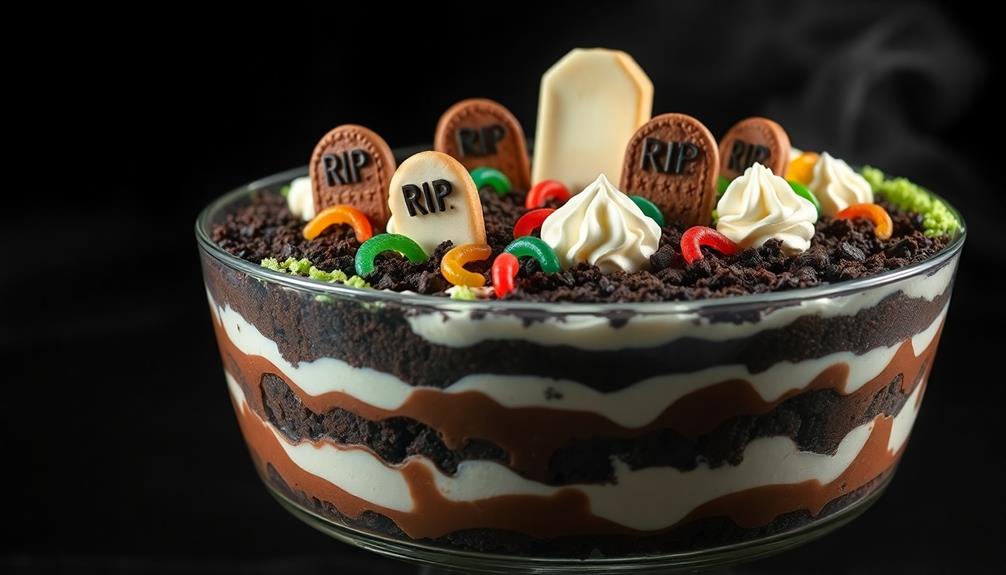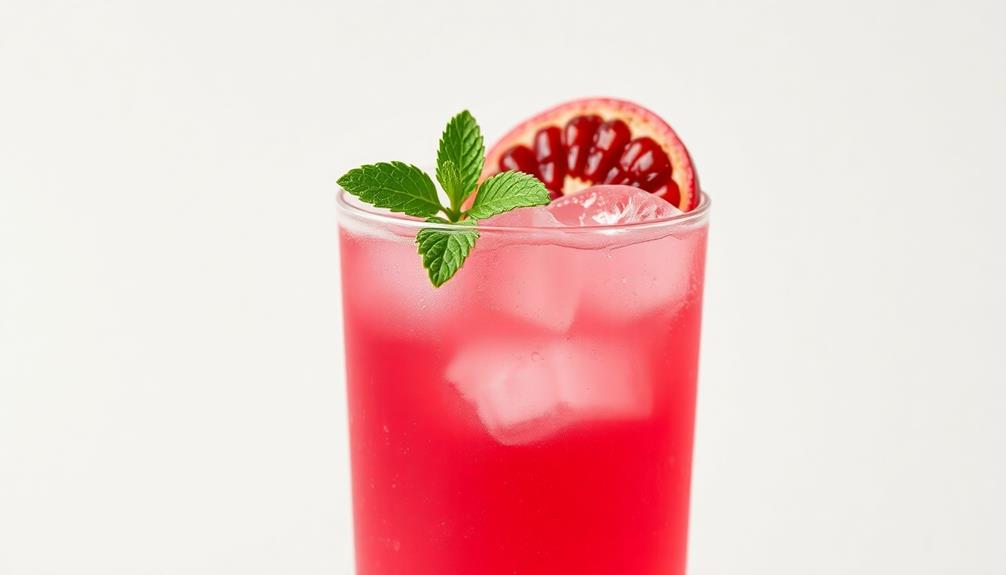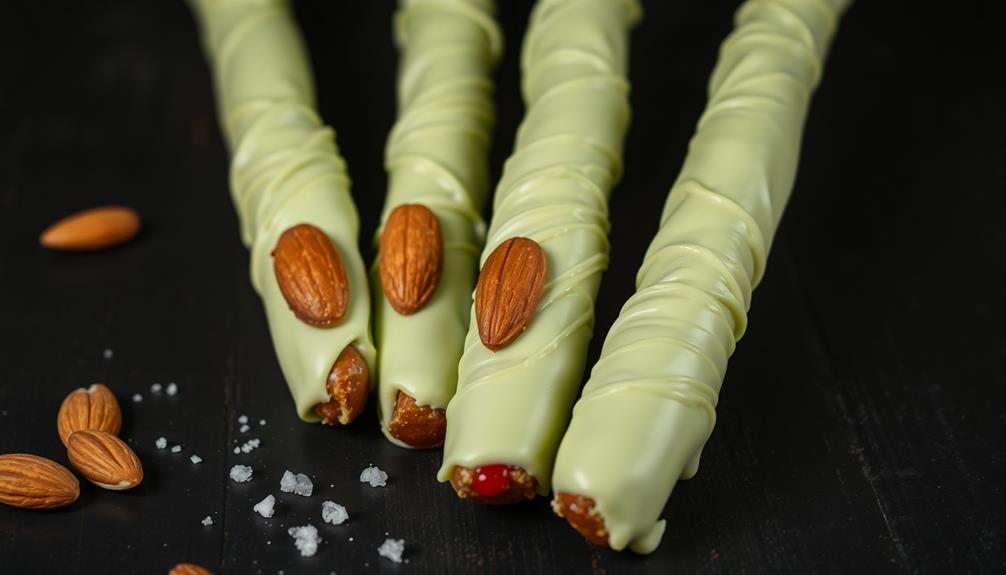To create stunning edible decorations with cookies, fondant, and fruit, you’ll want to select the right cookies—crisp sugar for intricate shapes or buttery shortbread for flavor. Use fondant to craft detailed toppers, coloring it with gel or paste for vibrant hues and textures. Incorporate fresh or carved fruit for brightness and natural charm. Combining these elements enhances your desserts beautifully. Keep everything fresh and well-stored, and discover tips to elevate your edible decorations even further.
Key Takeaways
- Choose sturdy, flavorful cookies like sugar or shortbread for durable, attractive decorations and themed presentations.
- Use high-quality gel or paste colors to tint fondant for vibrant, customized edible decorations.
- Incorporate fruit in decorations by slicing or carving bright, fresh produce for visual impact and flavor enhancement.
- Employ texturing techniques such as embossing, veining, or stamping to add realistic surface details to fondant and cookies.
- Store edible decorations in airtight containers away from moisture and humidity to maintain freshness and prevent spoilage.
Choosing the Right Cookies for Edible Decorations
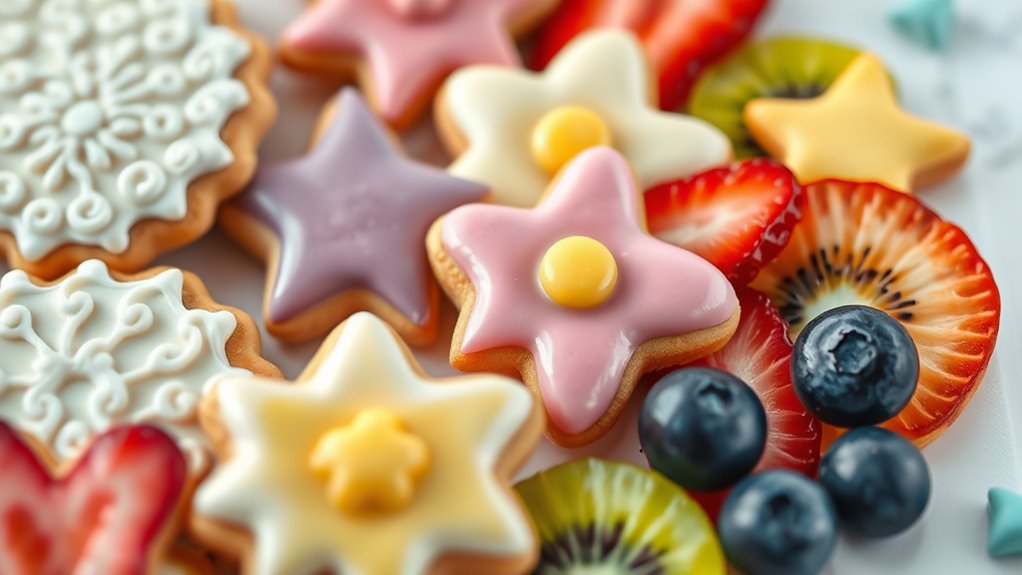
Choosing the right cookies for edible decorations is essential to guarantee your designs turn out both beautiful and delicious. Your selection of cookie varieties sets the foundation for a successful decoration. For example, crisp sugar cookies are perfect for intricate shapes because they hold their form well, while buttery shortbread offers a rich flavor that enhances your presentation. When considering flavor pairings, think about complementary tastes—lemon cookies work beautifully with fruit-based decorations, and spice cookies add warmth to festive designs. Opt for cookies that are sturdy yet tasty, ensuring they don’t crumble easily but still taste great. Additionally, the texture of the cookie plays a crucial role in how well it can be decorated and how it holds up over time. By choosing the right cookie varieties and considering flavor pairings, you create edible decorations that are as delightful to eat as they are to look at.
Techniques for Decorating With Fondant

Decorating with fondant requires precise techniques to achieve a smooth, professional finish. Start by kneading the fondant until it’s soft and pliable, then roll it out evenly using a matte or cornstarch-dusted surface to prevent sticking. When working with cookie shapes, trim excess fondant to match each form closely, ensuring clean edges. To create different fondant textures, use tools like embossing mats or textured rollers, pressing gently to add patterns without tearing. Smooth the surface with a fondant smoother, working from the center outward to eliminate air bubbles and wrinkles. For detailed designs, cut out shapes with cookie cutters or craft knives, then adhere them with a dab of edible glue or water. Mastering these techniques results in beautifully decorated cookies with flawless fondant finishes. Incorporating a vintage decor element can add rustic charm to your themed treats.
Creative Fruit Garnishing Ideas
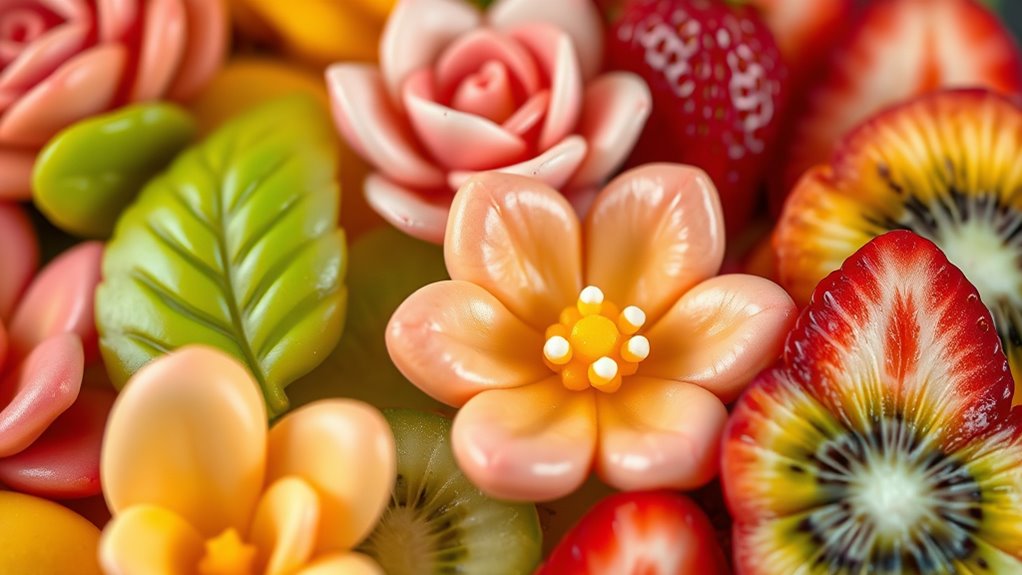
Adding creative fruit garnishes can transform simple dishes into stunning visual displays. Fruit carving allows you to craft intricate shapes like roses, leaves, or animals, elevating your presentation. Use sharp knives and precision to carve melons, apples, or pineapples into delicate designs that catch the eye. Edible flower arrangements made from thinly sliced fruit or edible flowers add a touch of elegance and color. Arrange strawberries, kiwi, or mango slices in floral patterns or cascading designs for a vibrant effect. These garnishes enhance salads, desserts, or drinks, making them more appealing. Combining fruit carving with edible flower arrangements creates a harmonious, visually striking display that impresses guests and adds a professional touch to your culinary creations. Incorporating boho decor elements like natural textures and vibrant patterns can also enhance the overall presentation of your edible decorations.
Tools and Supplies for Edible Embellishments
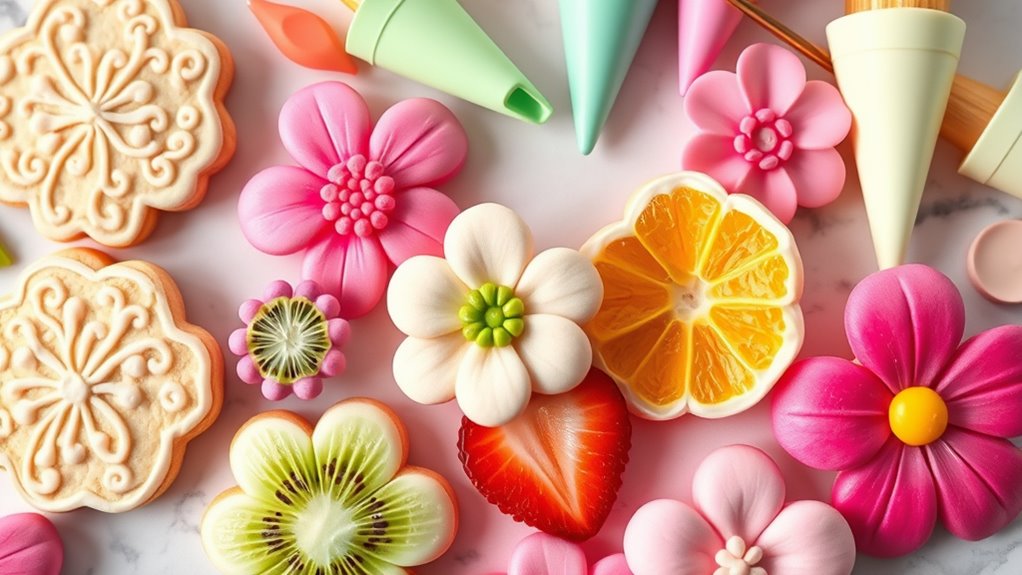
To create beautiful edible decorations, you need the right tools and supplies. Essential decorating tools include precision knives, piping tips, and brushes, while specialty edible supplies might be fondant, edible gold leaf, or colored sugars. Proper storage and maintenance guarantee your supplies stay fresh and ready for your next creative project. Additionally, understanding the divorce process in various states can help you navigate legal procedures if needed.
Essential Decorating Tools
Having the right tools is essential for creating beautiful edible decorations. Cake molds help you shape cookies, fondant, and fruit into professional-looking designs effortlessly. They come in various shapes and sizes, allowing for creative versatility. A small, flexible spatula is perfect for smoothing fondant or spreading edible glitter smoothly onto surfaces. Tweezers are invaluable for placing tiny decoration details precisely. Edible glitter adds sparkle and elegance; guarantee you have a good-quality brand that adheres well without clumping. Piping bags and nozzles enable intricate icing designs or detailed accents. Keep a palette knife nearby for lifting delicate pieces or spreading. With these essential tools—cake molds, edible glitter, and precision implements—you’ll elevate your edible decorations from simple to stunning. Incorporating high-tech tools such as automated decorating devices can further enhance efficiency and precision in your edible embellishments.
Specialty Edible Supplies
Ever wonder how professional-looking edible embellishments achieve their intricate detail and precision? It’s all about using the right specialty edible supplies. These tools elevate your decorating game, aligning with current bakery trends that emphasize creativity and customization. Plus, they help you cater to dietary considerations, offering options like vegan or gluten-free embellishments. Think fine tip brushes, silicone molds, edible pens, and airbrush kits—essential for detailed designs. Here’s a quick look:
| Tool | Purpose |
|---|---|
| Edible Pens | Precise lettering and accents |
| Silicone Molds | Reproducible shapes and textures |
| Airbrush Kits | Smooth color application |
| Piping Tips | Intricate piping designs |
| Food-safe Brushes | Spot details and textures |
Using these supplies guarantees your decorations are professional, on-trend, and inclusive for all dietary needs. Incorporating specialty edible supplies ensures your creations stand out with consistent, high-quality results.
Storage and Maintenance
Proper storage and maintenance are essential to keep your edible decorating tools in top condition and guarantee your embellishments stay fresh and vibrant. To maximize edible decoration durability, choose appropriate storage container options that protect your tools from moisture, dust, and damage. Airtight containers work well for delicate items like fondant cutters and piping tips, preventing them from drying out or becoming dull. Label your containers for easy identification and organize your supplies in a way that minimizes clutter and accidental breakage. Regularly clean and inspect your tools, ensuring they’re dry before storing. Proper maintenance extends their lifespan and preserves the quality of your decorations, making your edible embellishments look professional and stay fresh longer. Additionally, understanding dog breeds can help inform the best tools and storage solutions for your specific decorating needs, especially if you have a dog that loves to help in the kitchen.
Tips for Coloring and Texturing Fondant
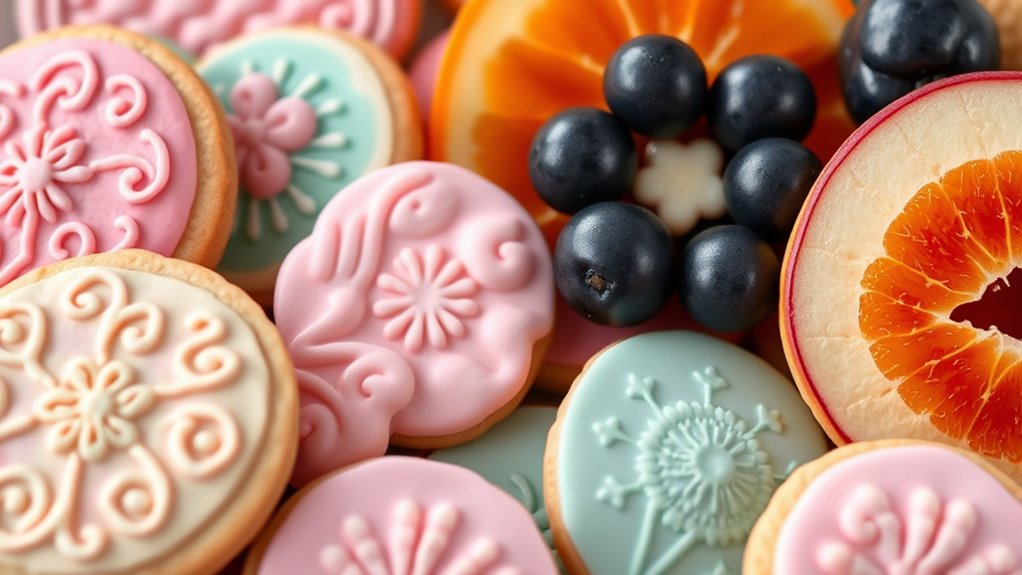
Getting vibrant colors on fondant is easier when you choose quality gel or paste colors and add them gradually. You can create realistic textures by using simple tools or techniques to shape and carve your fondant. Mixing and blending different shades helps achieve seamless progressions and unique hues for your decorations. Incorporating special occasion themes into your designs can enhance their appeal and relevance.
Achieving Vibrant Colors
To achieve vibrant colors in your fondant decorations, start by choosing high-quality gel or paste colorings rather than liquid dyes, as they provide intense pigmentation without thinning your fondant. For best results, use edible paint to add depth and shine, especially on darker shades. When coloring, experiment with color mixing to create custom hues—combine primary colors gradually for precise shades. Always wear gloves to prevent staining and knead the fondant thoroughly for even color distribution. Here’s a quick guide:
| Color Type | Best Use | Tips |
|---|---|---|
| Gel/Paste | Base colors | Use sparingly for vibrant results |
| Edible Paint | Highlights and accents | Apply with brushes for detail |
| Color Mixing | Custom shades | Mix small amounts until desired hue |
Mastering these techniques will ensure your fondant pops with vivid, professional-quality color.
Texturing Techniques for Realism
Adding texture to your fondant decorations brings them to life, making them look more realistic and visually appealing. You can achieve this through various texturing techniques, such as pressing with textured tools, stamping patterns, or using veining brushes. These methods create realistic surface effects that mimic natural textures like bark, fabric, or skin. When applying texturing techniques, focus on the details—lightly pressing or dragging tools to add subtle variations enhances authenticity. Use small silicone molds or impression mats to add intricate patterns effortlessly. Remember, the goal is to replicate the surface you’re imitating, so experiment with different tools and pressure levels. Skillful texturing transforms flat fondant into stunning, lifelike decorations that captivate and elevate your cake designs. Incorporating WWE Raw’s financial impact insights can inspire you to invest in high-quality tools that elevate your craft.
Mixing and Blending Tips
When coloring and texturing fondant, thorough mixing is essential to achieve consistent, vibrant results. Begin by kneading the fondant well to ensure even color distribution, especially when using gel or paste colors. To enhance flavor pairings, consider adding small amounts of flavor extracts during mixing, but be mindful of ingredient substitutions that might alter texture or color absorption. For example, replacing glycerin with corn syrup can affect pliability but still allow for smooth blending. When blending colors, start with a small amount and gradually add more to avoid over-coloring. Proper mixing prevents streaks and creates a uniform base for decorating. This careful approach guarantees your fondant not only looks appealing but also maintains a pleasant taste and workable consistency. Additionally, understanding the role of gaslighting tactics in manipulative behaviors can help in navigating complex social or emotional situations involving subtle influence.
Incorporating Cookies Into Themed Desserts

Incorporating cookies into themed desserts allows you to create visually appealing and personalized treats that enhance any celebration. Choose from a variety of cookie varieties like shortbread, sugar cookies, or biscotti to match your theme. Consider flavor pairings such as lemon and lavender or chocolate and peppermint to add depth. To elevate your dessert, try these ideas:
- Use decorated cookies as cupcake toppers for a cohesive look.
- Layer cookie crumbs at the base of parfaits for texture and flavor.
- Incorporate cookies into cake layers or fillings for added richness.
- Create cookie-shaped accents or signs that mirror your theme.
Using Fruit to Add Vibrancy and Freshness

Fruits can instantly boost the visual appeal and vibrancy of your desserts, making them more inviting and flavorful. When selecting fruit for decoration, consider fruit pairing to ensure flavors complement each other and enhance the overall taste. Use bright, colorful fruits like strawberries, blueberries, or kiwi to achieve striking color enhancement on your desserts. Sliced or diced fruit can be arranged artfully on cakes, tarts, or parfaits, adding a vibrant pop of color that draws the eye. Fresh fruit not only provides a natural, juicy texture but also signals freshness, making your dessert more appealing. Keep in mind that the right fruit choices can elevate your presentation while adding a invigorating, natural sweetness that balances richer components.
Combining Cookies, Fondant, and Fruit for Stunning Designs
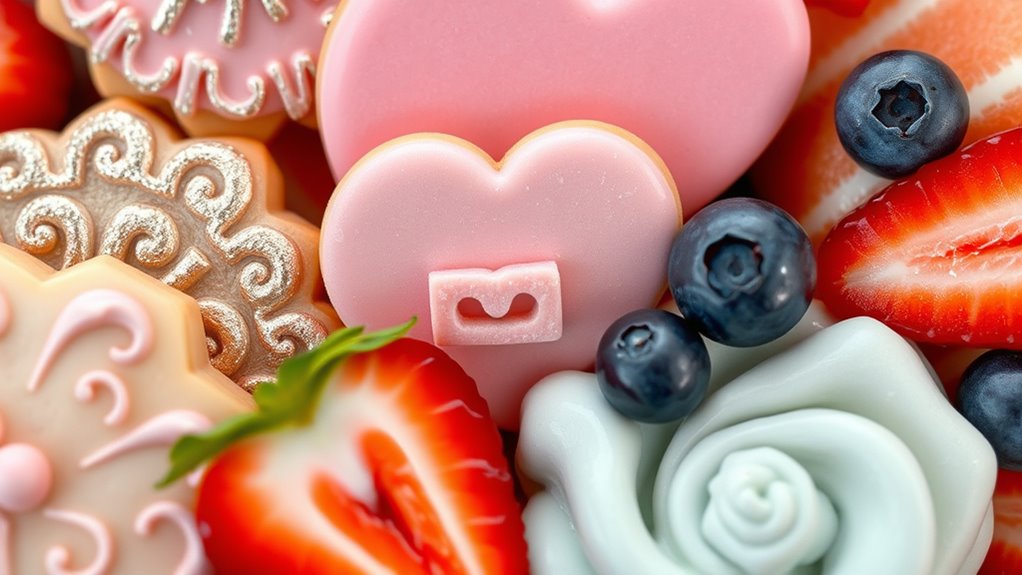
To create stunning designs, you need to balance textures and colors between cookies, fondant, and fruit, making each element complement the others. Using layering and assembly techniques helps bring your vision to life, adding depth and sophistication. Let your creativity run free by exploring themes and inspirations that inspire unique combinations and eye-catching arrangements. Paying attention to resources and tools available can also enhance your decorating process, ensuring professional-looking results.
Harmonizing Textures and Colors
Harmonizing textures and colors is essential for creating visually striking edible decorations. You want each element—cookies, fondant, and fruit—to complement rather than compete. Start by considering flavor pairings; combining sweet, tangy, and savory notes adds depth. Incorporate cultural traditions to select colors and textures that resonate visually and culturally. To deepen your design, consider these aspects:
- Balance smooth fondant with textured cookies or fruit for contrast
- Use color schemes inspired by cultural themes or seasonal palettes
- Match fruit colors with fondant accents to unify the design
- Layer textures thoughtfully to highlight key features and create visual interest
- Incorporate water-based techniques to achieve delicate effects and enhance overall harmony
Techniques for Layering and Assembly
Ever wondered how to seamlessly combine cookies, fondant, and fruit into a cohesive edible decoration? Start by layering your components strategically. Use fondant sculpting techniques to create smooth, detailed shapes that fit perfectly atop cookies. When attaching fondant to cookies, apply a thin layer of edible glue or buttercream as adhesive. For added sparkle, sprinkle edible glitter over fondant surfaces before assembling, ensuring it adheres evenly and highlights your design. When layering fruit, cut it into uniform shapes and place it carefully to maintain balance and visual appeal. Secure each layer firmly but gently to avoid damage. Additionally, choosing the right adhesive material can make a significant difference in the durability of your decoration. With patience and precision, these techniques help you achieve stunning, professional-looking decorations that beautifully showcase the textures and colors of your edible elements.
Creative Inspiration and Themes
Creative themes and inspiration can transform simple edible decorations into stunning art pieces. By thoughtfully combining cookies, fondant, and fruit, you create eye-catching designs that captivate. Start with popular cookie themes like seasonal, floral, or whimsical to set a strong foundation. Incorporate fruit motifs such as citrus slices, berries, or apple slices to add natural color and texture. To elevate your creations, consider these ideas:
- Mix classic holiday cookie themes with fresh fruit accents for a vibrant display.
- Use fondant to craft detailed motifs that complement the fruit’s natural shapes.
- Combine contrasting colors and textures for visual interest.
- Incorporate thematic elements like leaves or flowers to unify your design.
These approaches help you craft edible decorations that are both beautiful and memorable.
Storage and Preservation of Edible Decorations
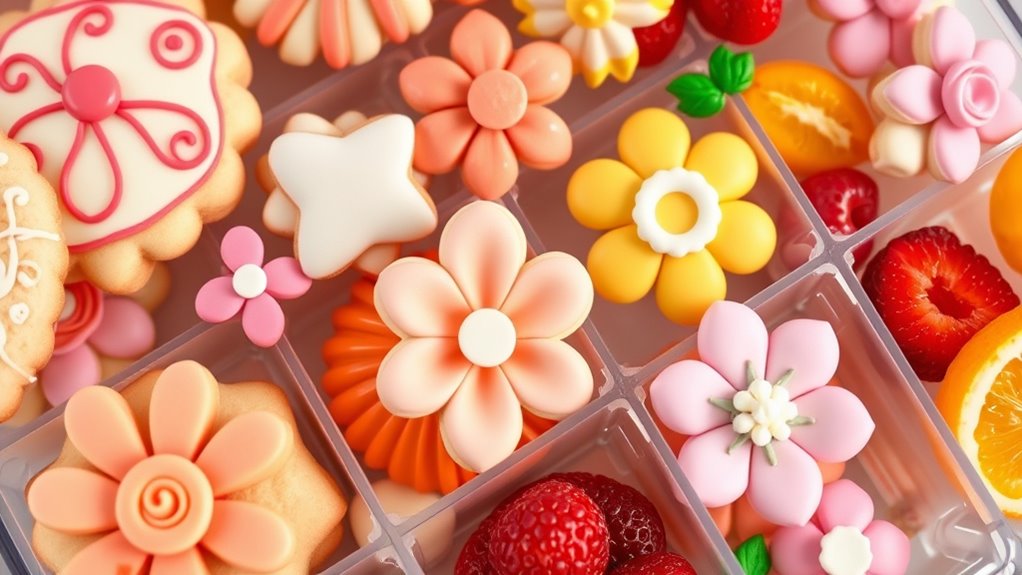
Proper storage is essential to keep edible decorations fresh and maintain their appearance. To stay aligned with current edible decoration trends, store cookies, fondant, and fruit in airtight containers to prevent moisture and spoilage. For fondant decorations, keep them in a cool, dry place away from direct sunlight to preserve their color and texture. Fresh fruit should be refrigerated and consumed promptly to prevent spoilage and nutrient loss, considering nutritional considerations. When storing decorated cookies, place parchment paper between layers to avoid sticking or damage. Proper packaging not only prolongs shelf life but also helps maintain visual appeal. Regularly check stored decorations for signs of spoilage, and adjust storage conditions accordingly to ensure your edible creations remain vibrant and delicious. Additionally, understanding proper maintenance and cleaning techniques can help prevent mold growth and contamination during storage.
Inspiring Ideas for Special Occasions
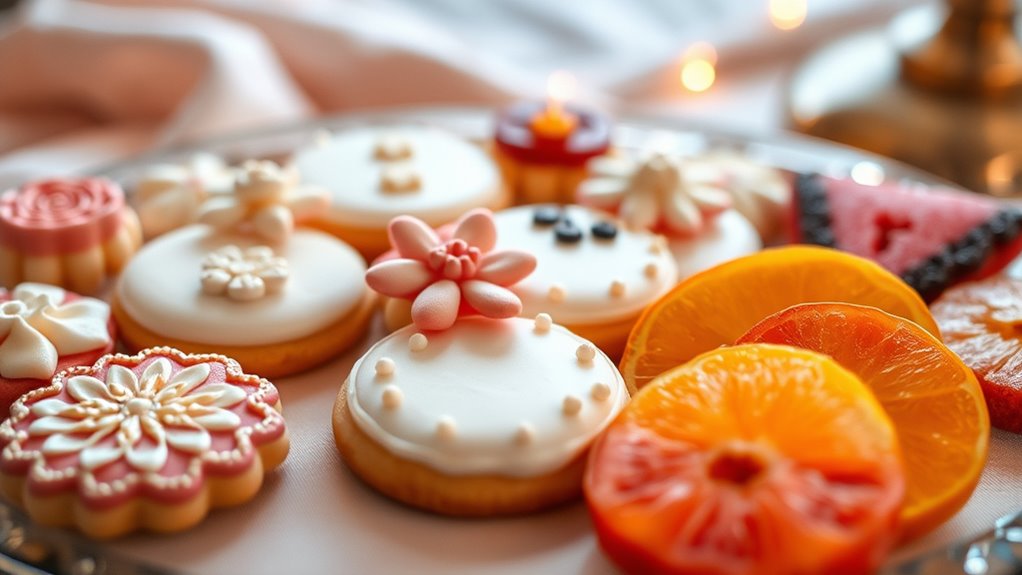
When you’ve mastered storing and preserving edible decorations, you’re ready to transform them into stunning displays for special occasions. Incorporate seasonal patterns like snowflakes for winter or leaves for autumn to set the mood. Use cultural symbolism, such as traditional motifs for holidays or celebrations, to add meaningful touches. Here are some ideas to inspire you:
- Decorate cookies with festive seasonal patterns for holidays like Christmas or Halloween.
- Create fondant toppers that showcase cultural symbols, like cherry blossoms or religious icons.
- Use fruit arrangements that reflect seasonal themes, such as citrus for summer or pomegranate for fall.
- Design edible centerpieces with themed motifs that honor specific cultural traditions or celebrations.
- Understanding the history of butter and its significance in various cultures can inspire authentic and meaningful edible decorations for special occasions.
These ideas help personalize your edible decorations, making each occasion memorable.
Frequently Asked Questions
How Long Can Edible Decorations Be Stored Before They Spoil?
You can typically store edible decorations for up to a week to prevent spoilage, but it depends on the type. Cookies last about 1-2 weeks if kept in an airtight container, while fondant decorations stay good for 2-4 weeks if properly stored. Fruits should be eaten within a few days. To prevent spoilage, always keep decorations in a cool, dry place, and avoid exposure to moisture or direct sunlight.
Are There Health Considerations When Using Artificial Coloring in Fondant?
Imagine you’re preparing a fondant cake for a wedding. You should be aware that artificial dyes, while FDA-approved, may contain food safety concerns for some people. It’s best to use food-safe, high-quality artificial coloring and avoid excess. Always check labels and opt for natural alternatives when possible. This reduces risks and guarantees your decorations are safe for all guests, especially those with sensitivities or allergies.
Can Edible Decorations Be Made Gluten-Free or Allergy-Friendly?
Yes, you can make edible decorations gluten-free and allergy-friendly. You should use gluten-free alternatives like almond or rice flour for cookies and fondant. Look for allergy-friendly ingredients, such as plant-based dyes and natural flavorings, to avoid common allergens. Always check ingredient labels carefully and consider making your own decorations to guarantee they meet dietary needs. This way, everyone can enjoy your beautifully crafted, safe treats.
What Are Eco-Friendly Options for Packaging Edible Decorations?
You can opt for eco-friendly packaging options like biodegradable wrapping or reusable containers to reduce waste. These choices keep your edible decorations fresh while being kind to the environment. Some biodegradable wraps decompose quickly and are made from plant-based materials, making them a sustainable choice. Reusable containers, like glass jars or metal tins, allow you to store and display your decorations beautifully, lowering your ecological footprint and showcasing your commitment to sustainability.
How Do I Prevent Cookies and Fruit From Wilting or Drying Out?
To prevent cookies and fruit from wilting or drying out, focus on proper storage techniques that enhance moisture retention. Keep cookies in airtight containers at room temperature or slightly cooler, avoiding direct sunlight. For fruit, store in the fridge in breathable or moisture-controlled containers. Wrapping items with plastic wrap or using vacuum-sealed bags can also aid in maintaining freshness. Regularly check stored items to ensure they stay hydrated and appealing.
Conclusion
So, now that you’re a veritable Picasso of edible decor, go ahead—embellish everything from cookies to fruit, and watch your friends marvel at your “art.” Remember, if your masterpiece crumbles or wilts, it’s just flavor’s way of saying, “Nice try.” Keep experimenting, stay colorful, and maybe invest in a fire extinguisher—because with your skills, you’re bound to turn a simple treat into a confectionary catastrophe. Happy decorating!
